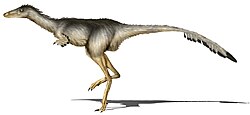Albertonykus
|
Albertonykus Temporal range: Late Cretaceous, 68.5 Ma |
|
|---|---|
 |
|
| Life restoration | |
| Scientific classification | |
| Kingdom: | Animalia |
| Phylum: | Chordata |
| Class: | Reptilia |
| Clade: | Dinosauria |
| Order: | Saurischia |
| Suborder: | Theropoda |
| Family: | †Alvarezsauridae |
| Genus: |
†Albertonykus Longrich & Currie, 2009 |
| Species: | †A. borealis |
| Binomial name | |
|
Albertonykus borealis Longrich & Currie, 2009 |
|
Albertonykus (meaning "Alberta claw") is a genus of alvarezsaurid dinosaur from Maastrichtian-age (Upper Cretaceous) rocks of the Horseshoe Canyon Formation of Alberta, Canada. It is known from forelimb and hindlimb remains from multiple individuals. All but two of the specimens come from a bonebed dominated by Albertosaurus. This bonebed is located at the top of Unit 4 of the Horseshoe Canyon Formation, which dates to about 68.5 million years ago.Albertonykus is interpreted as having fed on wood-nesting termites because the forelimbs appear to be specialized for digging, but are too short for burrowing. Albertonykus is the earliest-known North American alvarezsaurid; isolated remains of alvarezsaurids are known from later rock units in Montana and Wyoming (USA).
The type species is A. borealis, described by Nicholas Longrich and Philip Currie in a paper published in 2009 (which was available online as a preprint in 2008). The specific name (borealis) means "north".
Until the 1990s it was unknown that dinosaurs like Albertonykus existed. A chain of new discoveries from Asia and South America exposed the existence of these previously unknown theropod dinosaurs. North American finds remained rare. The bones of Albertonykus were discovered through a coincidental association with a much larger theropod dinosaur. In 1910, paleontologist Barnum Brown and his crew found a site filled with the bones of the gigantic tyrannosaurid Albertosaurus sarcophagus. They unearthed the remains of at least nine different specimens of Albertosaurus in the single site, but stopped digging after just two weeks. Renewed quarrying in the Albertosaurus bonebed in Dry Island Provincial Park again produced the remains of over twenty specimens of Albertosaurus, and the quarry has yet to be fully excavated. It is not known why so many tyrannosaurs were found in one place: paleontologist Nick Longrich speculated that the site was part of a "predator trap", where food drew predators to their deaths. At the same site, over a dozen arm and leg bones belonging to an unknown species of small theropod were in 2002 excavated by a team of scientist led by Philip John Currie of the University of Alberta. The bones were then stored at the Royal Tyrrell Museum in Alberta.
...
Wikipedia
